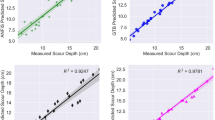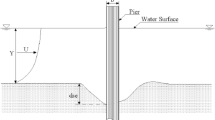Abstract
Studies have shown that the major cause of the bridge failures is the local scour around the pier foundations or their abutments. The local scour around the bridge pier is occurred by changing the flow pattern and creating secondary vortices in the front and rear of the bridge piers. Until now, many researchers have proposed empirical equations to estimate the bridge pier scour based on laboratory and field datasets. However, scale impact, laboratory simplification, natural complexity of rivers and the personal judgement are among the main causes of inaccuracy in the empirical equations. Therefore, due to the deficiencies and disadvantages of existing equations and the complex nature of the local scour phenomenon, in this study, the adaptive network-based fuzzy inference system (ANFIS) and teaching–learning-based optimization (TLBO) method were combined and used. The parameters of the ANFIS were optimized by using TLBO optimization method. To develop the model and validate its performance, two datasets were used including laboratory dataset that consisted of experimental results from the current study and previous ones and the field dataset. In total, 27 scaled experiments of different types of pier groups with different cross sections and side slopes were carried out. To evaluate the model ability in prediction of scour depth, results were compared to the standard ANFIS and empirical equations using evaluation functions including Hec-18, Froehlich and Laursen and Toch equations. The results showed that adding TLBO to the standard ANFIS was efficient and can increase the model capability and reliability. Proposed model achieved better results than Laursen and Toch equation which had the best results among empirical relationships. For instance, proposed model in comparison with the Laursen and Toch equation, based on the RMSE function, yielded 50.4% and 71.8% better results in laboratory and field datasets, respectively.













Similar content being viewed by others
References
Briaud J-L, Ting FC, Chen H, Gudavalli R, Perugu S, Wei G (1999) SRICOS: prediction of scour rate in cohesive soils at bridge piers. J Geotech Geoenviron Eng 125(4):237–246. https://doi.org/10.1061/(ASCE)1090-0241(1999)125:4(237)
Clopper P, Lagasse P, Zevenbergen L (2007) Bridge pier scour countermeasures. In: World environmental and water resources congress 2007: restoring our natural habitat, pp 1–13. https://doi.org/10.1061/40927(243)380
Kothyari UC, Kumar A (2012) Temporal variation of scour around circular compound piers. J Hydraul Eng 138(11):945–957. https://doi.org/10.1061/(ASCE)HY.1943-7900.0000593
Chiew Y-M (1992) Scour protection at bridge piers. J Hydraul Eng 118(9):1260–1269. https://doi.org/10.1061/(ASCE)0733-9429(1992)118:9(1260)
Kattell J, Eriksson M (1998) Bridge scour evaluation: screening, analysis, & countermeasures (No. 9877 1207--SDTDC). https://trid.trb.org/view/660887
Shirole A, Holt R (1991) Planning for a comprehensive bridge safety assurance program. Transp Res Rec 1290:39–50
Roulund A, Sumer BM, Fredsøe J, Michelsen J (2005) Numerical and experimental investigation of flow and scour around a circular pile. J Fluid Mech 534:351–401. https://doi.org/10.1017/S0022112005004507
Laursen EM, Toch A (1956) Scour around bridge piers and abutments, vol 4. Iowa Highway Research Board Ames, Ames
Breusers H, Nicollet G, Shen H (1977) Local scour around cylindrical piers. J Hydraul Res 15(3):211–252. https://doi.org/10.1080/00221687709499645
Melville B, Sutherland A (1988) Design method for local scour at bridge piers. J Hydraul Eng 114(10):1210–1226. https://doi.org/10.1061/(ASCE)0733-9429(1988)114:10(1210)
Mia MF, Nago H (2003) Design method of time-dependent local scour at circular bridge pier. J Hydraul Eng 129(6):420–427. https://doi.org/10.1061/(ASCE)0733-9429(2003)129:6(420)
Richardson EV, Harrison LJ, Richardson J, Davis S (1993) Evaluating scour at bridges (No. HEC 18 (2nd edition)). https://trid.trb.org/view/412796
Mueller DS, Wagner CR (2005) Field observations and evaluations of streambed scour at bridges (No. FHWA-RD-03-052). https://trid.trb.org/view/756735
McIntosh J (1989) Use of scour prediction formulae. In: Proceedings of the bridge scour symposium, McLean, VA, Federal Highway Administration Research Report FHWA-RD-90-035, pp 78–100
Pal M, Singh N, Tiwari N (2011) Support vector regression based modeling of pier scour using field data. Eng Appl Artif Intell 24(5):911–916. https://doi.org/10.1016/j.engappai.2010.11.002
Sheppard D, Melville B, Demir H (2013) Evaluation of existing equations for local scour at bridge piers. J Hydraul Eng 140(1):14–23. https://doi.org/10.1061/(ASCE)HY.1943-7900.0000800
Kaveh A, Talatahari S (2010) A novel heuristic optimization method: charged system search. Acta Mech 213(3):267–289. https://doi.org/10.1007/s00707-009-0270-4
Talatahari S, Gandomi AH, Yun GJ (2014) Optimum design of tower structures using firefly algorithm. Struct Des Tall Spec Build 23(5):350–361. https://doi.org/10.1002/tal.1043
Talatahari S, Azar BF, Sheikholeslami R, Gandomi A (2012) Imperialist competitive algorithm combined with chaos for global optimization. Commun Nonlinear Sci Numer Simul 17(3):1312–1319. https://doi.org/10.1016/j.cnsns.2011.08.021
Talatahari S, Kheirollahi M, Farahmandpour C, Gandomi AH (2013) A multi-stage particle swarm for optimum design of truss structures. Neural Comput Appl 23(5):1297–1309. https://doi.org/10.1007/s00521-012-1072-5
Azamathulla HM, Deo M, Deolalikar P (2008) Alternative neural networks to estimate the scour below spillways. Adv Eng Softw 39(8):689–698. https://doi.org/10.1016/j.advengsoft.2007.07.004
Choi SU, Cheong S (2006) Prediction of local scour around bridge piers using artificial neural networks. JAWRA J Am Water Resour Assoc 42(2):487–494. https://doi.org/10.1111/j.1752-1688.2006.tb03852.x
Kaveh A, Zakian P (2018) Improved GWO algorithm for optimal design of truss structures. Eng Comput 34(4):685–707. https://doi.org/10.1007/s00366-017-0567-1
Kaveh A, Dadras A, Malek NG (2018) Optimum stacking sequence design of composite laminates for maximum buckling load capacity using parameter-less optimization algorithms. Eng Comput. https://doi.org/10.1007/s00366-018-0634-2
Kaveh A, Abedi M (2018) Analysis and optimal design of scissor-link foldable structures. Eng Comput. https://doi.org/10.1007/s00366-018-0618-2
Kambekar A, Deo M (2003) Estimation of pile group scour using neural networks. Appl Ocean Res 25(4):225–234. https://doi.org/10.1016/j.apor.2003.06.001
Firat M, Gungor M (2009) Generalized regression neural networks and feed forward neural networks for prediction of scour depth around bridge piers. Adv Eng Softw 40(8):731–737. https://doi.org/10.1016/j.advengsoft.2008.12.001
Zounemat-Kermani M, Beheshti A-A, Ataie-Ashtiani B, Sabbagh-Yazdi S-R (2009) Estimation of current-induced scour depth around pile groups using neural network and adaptive neuro-fuzzy inference system. Appl Soft Comput 9(2):746–755. https://doi.org/10.1016/j.asoc.2008.09.006
Muzzammil M (2010) ANFIS approach to the scour depth prediction at a bridge abutment. J Hydroinformatics 12(4):474–485. https://doi.org/10.2166/hydro.2010.004
Najafzadeh M, Barani G-A, Azamathulla HM (2013) GMDH to predict scour depth around a pier in cohesive soils. Appl Ocean Res 40:35–41. https://doi.org/10.1016/j.apor.2012.12.004
Chou J-S, Pham A-D (2014) Hybrid computational model for predicting bridge scour depth near piers and abutments. Autom Constr 48:88–96. https://doi.org/10.1016/j.autcon.2014.08.006
Cheng M-Y, Cao M-T, Wu Y-W (2014) Predicting equilibrium scour depth at bridge piers using evolutionary radial basis function neural network. J Comput Civ Eng 29(5):04014070. https://doi.org/10.1061/(ASCE)CP.1943-5487.0000380
Najafzadeh M (2015) Neuro-fuzzy GMDH systems based evolutionary algorithms to predict scour pile groups in clear water conditions. Ocean Eng 99:85–94. https://doi.org/10.1016/j.oceaneng.2015.01.014
Chou J-S, Pham A-D (2017) Nature-inspired metaheuristic optimization in least squares support vector regression for obtaining bridge scour information. Inf Sci 399:64–80. https://doi.org/10.1016/j.ins.2017.02.051
Khan MS, Coulibaly P (2006) Application of support vector machine in lake water level prediction. J Hydrol Eng 11(3):199–205. https://doi.org/10.1061/(ASCE)1084-0699(2006)11:3(199)
Sarzaeim P, Bozorg-Haddad O, Chu X (2018) Teaching-learning-based optimization (TLBO) algorithm. In: Bozorg-Haddad O (ed) Advanced optimization by nature-inspired algorithms. Springer, New York, pp 51–58. https://doi.org/10.1007/978-981-10-5221-7_6
Toğan V (2012) Design of planar steel frames using teaching–learning based optimization. Eng Struct 34:225–232. https://doi.org/10.1016/j.engstruct.2011.08.035
Roy PK, Sur A, Pradhan DK (2013) Optimal short-term hydro-thermal scheduling using quasi-oppositional teaching learning based optimization. Eng Appl Artif Intell 26(10):2516–2524. https://doi.org/10.1016/j.engappai.2013.08.002
Ji G, Wang J, Ge Y, Liu H (2014) Urban water demand forecasting by LS-SVM with tuning based on elitist teaching-learning-based optimization. In: Control and decision conference (2014 CCDC), the 26th Chinese. IEEE, pp 3997–4002. https://doi.org/10.1109/CCDC.2014.6852880
Jang J-S (1993) ANFIS: adaptive-network-based fuzzy inference system. IEEE Trans Syst Man Cybern 23(3):665–685. https://doi.org/10.1109/21.256541
Abraham A (2005) Adaptation of fuzzy inference system using neural learning. Fuzzy Syst Eng. https://doi.org/10.1007/11339366_3
Rao RV, Savsani VJ, Vakharia D (2011) Teaching–learning-based optimization: a novel method for constrained mechanical design optimization problems. Comput Aided Des 43(3):303–315. https://doi.org/10.1016/j.cad.2010.12.015
Shen HW, Schneider VR, Karaki S (1969) Local scour around bridge piers. J Hydraul Div 95(6):1919–1940
Ettema R (1980) Scour at bridge piers (No. 216 Monograph). https://trid.trb.org/view/171850
Whitehouse R (1998) Scour at marine structures: a manual for practical applications. Thomas Telford. https://doi.org/10.1680/sams.26551
Melville BW, Parola AC, Coleman SE (2008) Bridge-scour prevention and countermeasures. In: Sedimentation engineering: processes, measurements, modeling, and practice. American Society of Civil Engineers, Virginia, pp 543–577. https://doi.org/10.1061/9780784408148.ch11
Raudkivi AJ (1998) Loose boundary hydraulics. CRC Press, Boca Raton
Breusers H, Raudkivi A (1991) Scouring, hydraulic structures design manual, vol 143. IAHR, AA Balkema, Rotterdam
Raudkivi AJ, Ettema R (1983) Clear-water scour at cylindrical piers. J Hydraul Eng 109(3):338–350. https://doi.org/10.1061/(ASCE)0733-9429(1983)109:3(338)
Lauchlan CS, Melville BW (2001) Riprap protection at bridge piers. J Hydraul Eng 127(5):412–418. https://doi.org/10.1061/(ASCE)0733-9429(2001)127:5(412)
Melville BW, Chiew Y-M (1999) Time scale for local scour at bridge piers. J Hydraul Eng 125(1):59–65. https://doi.org/10.1061/(ASCE)0733-9429(1999)125:1(59)
Richardson E, Davis S (1995) Evaluating scour at bridges: Federal Highway Administration Hydraulic Engineering Circular No. 18. Publication FHWA-IP-90-017
Froehlich DC (1988) Analysis of onsite measurements of scour at piers. In: Hydraulic engineering: proceedings of the 1988 national conference on hydraulic engineering, pp 534–539
Author information
Authors and Affiliations
Corresponding author
Additional information
Publisher’s Note
Springer Nature remains neutral with regard to jurisdictional claims in published maps and institutional affiliations.
Rights and permissions
About this article
Cite this article
Hassanzadeh, Y., Jafari-Bavil-Olyaei, A., Aalami, MT. et al. Experimental and numerical investigation of bridge pier scour estimation using ANFIS and teaching–learning-based optimization methods. Engineering with Computers 35, 1103–1120 (2019). https://doi.org/10.1007/s00366-018-0653-z
Received:
Accepted:
Published:
Issue Date:
DOI: https://doi.org/10.1007/s00366-018-0653-z




